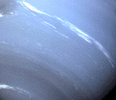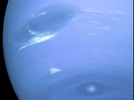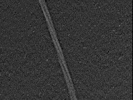
 |
 Neptune is the eighth planet from the Sun
and the fourth largest (by diameter).
Neptune is smaller in diameter but larger in mass than
Uranus.
Neptune is the eighth planet from the Sun
and the fourth largest (by diameter).
Neptune is smaller in diameter but larger in mass than
Uranus.
orbit: 4,504,000,000 km (30.06 AU) from Sun
diameter: 49,532 km (equatorial)
mass: 1.0247e26 kg
In Roman mythology
Neptune
(Greek:
Poseidon)
was the god of the Sea.
After the discovery of Uranus, it was noticed that its orbit was not as it
should be in accordance with Newton's laws.
 It was therefore predicted that another more distant planet must be
perturbing Uranus' orbit. Neptune was
first observed by Galle
and d'Arrest on 1846 Sept 23
very near to the locations independently predicted by
Adams and
Le Verrier
from calculations based on the observed
positions of Jupiter,
Saturn and Uranus.
An international dispute arose between the English and French
(though not, apparently between Adams and Le Verrier personally) over priority
and the right to name the new planet;
they are now jointly credited with Neptune's discovery.
Subsequent observations have shown
that the orbits calculated by Adams and Le Verrier diverge from Neptune's
actual orbit fairly quickly. Had the search for the planet taken place a few
years earlier or later it would not have been found anywhere near the predicted
location.
It was therefore predicted that another more distant planet must be
perturbing Uranus' orbit. Neptune was
first observed by Galle
and d'Arrest on 1846 Sept 23
very near to the locations independently predicted by
Adams and
Le Verrier
from calculations based on the observed
positions of Jupiter,
Saturn and Uranus.
An international dispute arose between the English and French
(though not, apparently between Adams and Le Verrier personally) over priority
and the right to name the new planet;
they are now jointly credited with Neptune's discovery.
Subsequent observations have shown
that the orbits calculated by Adams and Le Verrier diverge from Neptune's
actual orbit fairly quickly. Had the search for the planet taken place a few
years earlier or later it would not have been found anywhere near the predicted
location.
Neptune has been visited by only one spacecraft, Voyager 2 on Aug 25 1989. Almost everything we know about Neptune comes from this encounter.
Because Pluto's orbit is so eccentric, it sometimes crosses the orbit of Neptune. Since 1979 Neptune has actually been the most distant planet from the Sun; Pluto will again be the most distant in 1999.
Neptune's composition is probably similar to Uranus': various "ices" and rock with about 15% hydrogen and a little helium. Like Uranus, but unlike Jupiter and Saturn, it may not have a distinct internal layering but rather to be more or less uniform in composition. But there is most likely a small core (about the mass of the Earth) of rocky material. Its atmosphere is mostly hydrogen and helium with a small amount of methane.
Neptune's blue color is the result of absorption of red light by methane in the atmosphere.
Like a typical gas planet, Neptune has rapid winds confined to bands of latitude and large storms or vortices. Neptune's winds are the fastest in the solar system, reaching 2000 km/hour.
Like Jupiter and Saturn, Neptune has an internal heat source --
it radiates more than
twice as much energy as it receives from the Sun.
At the time of the Voyager encounter,
 Neptune's most prominent feature was
the Great Dark Spot (left) in the southern
Neptune's most prominent feature was
the Great Dark Spot (left) in the southern
 hemisphere. It was about half the
size as Jupiter's Great Red Spot (about the
same diameter as Earth). Neptune's winds blew the Great Dark
Spot westward at 300 meters/second (700 mph).
Voyager 2 also saw
a smaller dark spot in the southern hemisphere and
a small irregular
white cloud that zips around Neptune every 16 hours or so now known as
"The Scooter" (right). It may be a plume rising from lower in the atmosphere
but its true nature remains a mystery.
hemisphere. It was about half the
size as Jupiter's Great Red Spot (about the
same diameter as Earth). Neptune's winds blew the Great Dark
Spot westward at 300 meters/second (700 mph).
Voyager 2 also saw
a smaller dark spot in the southern hemisphere and
a small irregular
white cloud that zips around Neptune every 16 hours or so now known as
"The Scooter" (right). It may be a plume rising from lower in the atmosphere
but its true nature remains a mystery.
However, HST observations of
 Neptune (left) in 1994
show that the Great Dark Spot has disappeared! It has either simply
dissipated or is currently being masked by other aspects of the atmosphere.
A few months later HST discovered a new dark spot in Neptune's northern
hemisphere. This indicates that Neptune's atmosphere
changes rapidly, perhaps
due to slight changes in the temperature differences between the tops and bottoms
of the clouds.
Neptune (left) in 1994
show that the Great Dark Spot has disappeared! It has either simply
dissipated or is currently being masked by other aspects of the atmosphere.
A few months later HST discovered a new dark spot in Neptune's northern
hemisphere. This indicates that Neptune's atmosphere
changes rapidly, perhaps
due to slight changes in the temperature differences between the tops and bottoms
of the clouds.
 Neptune also has rings.
Earth-based observations showed only faint arcs instead
of complete rings, but Voyager 2's
images showed them to be complete rings with bright clumps.
One of the rings appears to have a curious twisted structure (right).
Neptune also has rings.
Earth-based observations showed only faint arcs instead
of complete rings, but Voyager 2's
images showed them to be complete rings with bright clumps.
One of the rings appears to have a curious twisted structure (right).
Like Uranus and Jupiter, Neptune's rings are very dark but their composition is unknown.
Neptune's rings have been given names: the outermost is Adams (which contains three prominent arcs now named Liberty, Equality and Fraternity), next is an unnamed ring coorbital with Galatea, then Leverrier (whose outer extensions are called Lassell and Arago), and finally the faint but broad Galle.
Neptune's magnetic field is, like Uranus', oddly oriented and probably generated by motions of conductive material (probably water) in its middle layers.
Neptune can be seen with binoculars (if you know exactly where to look) but a large telescope is needed to see anything other than a tiny disk. Mike Harvey's planet finder charts show the current position of Neptune (and the other planets) in the sky, but much more detailed charts will be required to actually find it. Such charts can be created with a planetarium program such as Starry Night.
Distance Radius Mass Satellite (000 km) (km) (kg) Discoverer Date --------- -------- ------ ------- ---------- ----- Naiad 48 29 ? Voyager 2 1989 Thalassa 50 40 ? Voyager 2 1989 Despina 53 74 ? Voyager 2 1989 Galatea 62 79 ? Voyager 2 1989 Larissa 74 96 ? Voyager 2 1989 Proteus 118 209 ? Voyager 2 1989 Triton 355 1350 2.14e22 Lassell 1846 Nereid 5509 170 ? Kuiper 1949
Distance Width Ring (km) (km) aka ------- -------- ----- ------- Diffuse 41900 15 1989N3R, Galle Inner 53200 15 1989N2R, LeVerrier Plateau 53200 5800 1989N4R, Lassell, Arago Main 62930 < 50 1989N1R, Adams(distance is from Neptune's center to the ring's inner edge)
